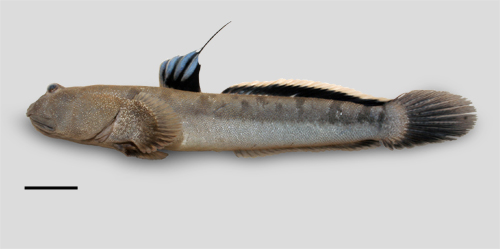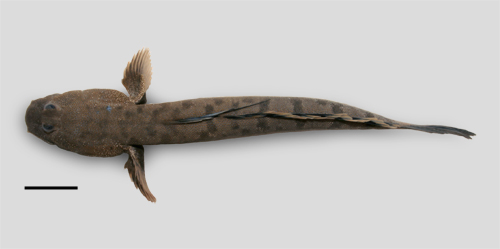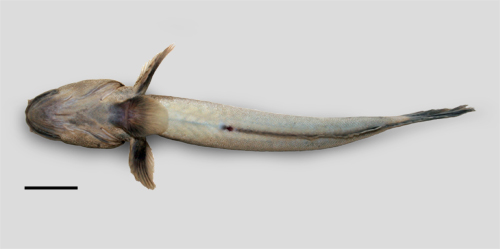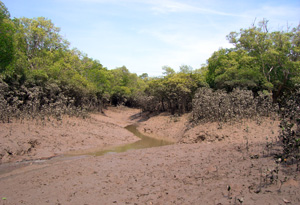Common names:
Australia |
English |
Birdsong's goggle-eyed goby |
China |
Chinese Mandarin |
北澳洲大弹涂鱼 (Bei ao zhou da tan tu yu - North Australian great mudskipper) |
Italy |
Italian |
boleoftalmo di Birdsong* |
* proposed name
|
|
|
Synonyms:
Boleophthalmus birdsongi |
Murdy, 1989 |
(senior synonym, original combination) |
Etymology:
'Boleophthalmus' depicts the capability of these fishes to rapidly raise their eyes above the level of their orbits, as if they were ejected out of their orbits: from 'bolê' (ejected), and 'ophthalmôn' (eye) (Cuvier & Valenciénnes, 1837)
this species is named after the gobiologist Ray S. Birdsong (Murdy, 1989)
|
Maximum recorded length:
111 mm SL (Takita et al., 2011)
Live colouration (Murdy, 1989;
pers. obs.: Australia, NT):
ground colour of the dorsal half of the body light brown; below midline and ventrally whitish to grey, yellowish under the head; gill cover, cheek and muscular portion of pectoral fins with many scattered small white spots, a few also on trunk; dark brown blotches on dorsum, head and nape in an irregular, alternate pattern may be visible, but never below lateral midline; a typical dark brown to dark slate to blackish, irregular stripe may be visible from behind pectoral fins up to caudal peduncle, along the lateral midline; D1 proximally and along rays densely black, pale blue to whitish for the rest;
D2 membrane basally white, with a wide densely black stripe and a white margin;
caudal fin blackish;
anal fin dark grey proximally, distally paler; pectoral fins pale brown, darker ventrally and at the attachment of rays; pelvic fins dark brown dorsally, ventrally dark brown on the proximal portion, paler for the rest
Colouration on preservation (Murdy, 1989;
pers. obs.: Australia NT):
ground colour greyish black to brown; dark lateral stripe and blotches on dorsum not always present; D1 completely blackened; D2 with a broad black to brown medial stripe, hyaline for the rest; caudal fin dark brown, medially darker; anal fin and pelvic fins hyaline, proximally darker; pectoral fins dark brown, dorsally paler
Diagnosis (Murdy, 1989):
total elements of D2 23-25;
total elements of anal fin 22-24; longitudinal scale count 89-111; predorsal scales 38-60; caudal fin length 17.9-24.6%SL; head length 26.6-31.1%SL;
length of D2 base 38.2-43.5%SL; 1st D2 element usually unsegmented and unbranched; lower jaw teeth lacking notches (not bifid). Shape and colouration of the dorsal fins, in
larger specimens (see Boleophthalmus poti, Remarks).
The genus is characterised by the greatly thickened epidermis of the head and dorsum, covered by dermal papillae; and by a rectangular piece of cartilage spanning the width of the
pelvic girdle (see drawing)
Diet:
No published study is available. However, it presents the typical feeding behaviour of other congeneric species (pers. obs.)
Reproduction:
No published study is available.
|
|
Ecological notes (Murdy, 1989; Takita et al., 2011; pers. obs.: Australia NT):
present on muddy banks of creeks and on tidal mudflats and mixed flats; there is an apparent ecological partition between larger and smaller individuals, the latter ones occuring at higher levels in the intertidal zone (Takita et al., 2011); this pattern is similar to that one demonstrated in B. boddarti (Polgar & Bartolino, 2010). In particular, the distribution of smaller individuals apparently fluctuates periodically following the synodic cycle, moving landwards during spring tides, and seawards during neap tides (Takita et al., 2011)
middle: Sadgrove's Creek, Darwin, NT, Australia; here several specimens were found, their burrows being up to a few meters from the water's edge at low tide (photo: A. Sacchetti, 2007)
|
|
|
|
Distribution:
northern Australia (Murdy, 1989; Takita et al., 2011)
|
Photographs of Boleophthalmus birdsongi:
|
A: a paratype of B. birdsongi: NTM S.11362-032 Darbilla Creek, Millingimbi, NT, Australia, coll. 1984 (photo: G. Polgar, Museum & Art Gallery of the Northern Territory, Darwin, NT, Australia, 2007); B: a specimen in very shallow water (photo: A. Sacchetti, 2007, Sadgrove's Creek, Darwin, Northern Territory, Australia)*; C-E:
a specimen coming out of its burrow, during feeding, and resting at the water edge; note the sandflies (Diptera: Ceratopogonidae) feeding on the mudskipper's head; smaller Periophthalmus sp. mudskippers are also visible (photo A. Sacchetti, Buffalo Creek, Northern Territory, Australia, 2007)*; F: the main opening of the burrow on the creek's bank (photo: A. Sacchetti, Sadgrove's Creek, Darwin, Northern Territory, Australia, 2007)*; G: a close-up of a specimen in aquarium (photo: G. Polgar, Museum & Art Gallery of the Northern Territory, Darwin, NT, Australia, 2007; collected in Sadgrove's Creek, Darwin); H: another shot in
aquarium (photo: G. Polgar, 2007) - * with permission
|
Drawings of Boleophthalmus birdsongi:
above, left: cephalic sensory and nasal pores of Boleophthalmus spp.: an= anterior nostril; ao= anterior oculoscapular canal pore;
pn= posterior nostril (modified from Murdy, 1989)*;
above, right: ventral view of pelvis of B. boddarti (pelvic fin elements removed from left side: modified from
Murdy, 1989): PIC= pelvic
intercleithral cartilage; Plv= pelvis; RC= rectangular cartilage; Plsp= pelvic fin spine (modified from Murdy, 1989)* - * with permission
|








